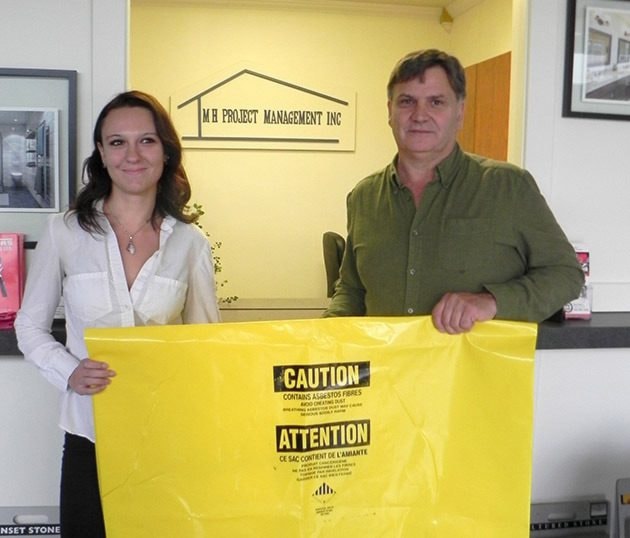Just because you can dump asbestos in the Bailey landfill now, doesn't mean you can throw caution to the wind and handle it unsafely.
Asbestos is still the dangerous, even deadly, fibre that homeowners and contractors have been warned about for the last several decades. However, since the City of Chilliwack opened up their landfill site to asbestos-containing materials, a local project management company has noticed a lot of misunderstanding leading to dangerous practices.
"People are showing up at the dump, expecting to be able to get rid of their materials," says Michael Hill, of MH Project Management. And that would be fine, if it were bagged, labelled and transported properly.
But what some people are forgetting, or ignoring, is that the materials still need to be handled carefully, from identifying asbestos right through to transportation. Hill and his staff are working at getting that message out through free, in-office information sharing sessions. Anyone can sign up, from the one-time renovating homeowner, to abatement and construction companies training new hires.
MH Project Management want to scream the message of safe asbestos handling from the rooftops.
"We care about our community, we don't want to see unsafe practices," says Hill. He cites recent Worksafe BC studies that show one person a week is dying from exposure to asbestos. And unlike some environmental dangers, asbestos only has to enter the lungs once to cause permanent damage. And it can take decades for that damage to show, and lead to asbestosis, and death.
Despite the seriousness of it all, dangerous practices are "out there," Hill says.
"It's happening. But I think with the proper awareness we can make a difference," he says.
So, this is what people need to know.
Asbestos is found in older homes, and becomes airborne when renovations or demolition create dust particles. It's in vermiculite insulation and drywall mud, as it is a strong, fire-resistant mineral fibre.
Hill teaches the proper methods for removing asbestos materials, and sells the proper bags and supplies needed. That includes wearing a proper respirator.
One day at the dump, Hills says he saw a mother and a grandmother with two little girls. All were wearing those white paper masks and handling asbestos-containing materials. At the very least, anyone handling this material needs to be wearing a NIOSH 100 (HEPA) filter-fitted respirator.
"That was an eye opener for us," he said. "It really made us think, 'Oh my, what's happening out there, if you're getting this message, how many other people are getting the message?'"
He thinks the City has done a great service offering asbestos dumping, as it could lead to lower local costs for abatement and fewer loads ending up in the rivers and bushes in the outskirts of town.
But he worries that some people didn't read the fine print, in that you can't just show up with a load of materials and hope for the best.
MH Project Management is called to Bailey by the City to assess materials that end up there, whether it's been "hidden" in other items, or shows up in the back of a pick up truck.
He calls it a "frenzy of asbestos mishandling," and is urging anyone renovating to do their homework.
City staff is working hard to inform people as well. They say appropriate bags and bagging techniques are essential to minimizing hazards for staff, customers, and the community. Their guidelines follow the Occupational Health and Safety Regulation Hazardous Waste Regulations.
They say: "To ensure acceptance for disposal, all asbestos waste must be double-bagged in 0.15 mm or 6 mil thick waste bags, gooseneck-tied at the top, sealed with duct-tape, and labeled “Asbestos”. For more information on appropriate bag tying procedures, residents can visit www.chilliwack.com/landfill and scroll down to a link at the bottom of the page titled “Proper Bag Tying Techniques”.
The website also includes important information pertaining to maximum bag sizes, bag limits, and disposal fees.
The City’s Engineering Department, 604-793-2907 can answer questions. For more information about sessions at MH Project Management, or what other services they provide, call 604-392-6476.
